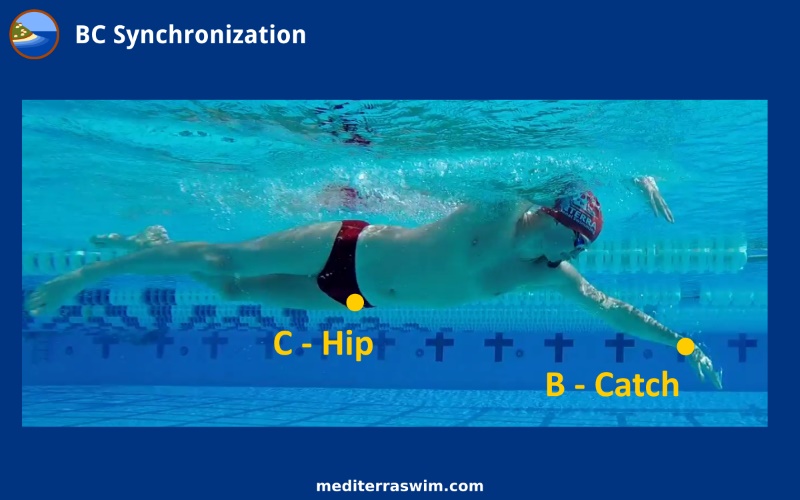Forums › Library › Swim Course Instructions › BC Synchronization Intro
Please type your comments directly in the reply box - DO NOT copy/paste text from somewhere else into the reply boxes - this will also copy the code behind your copied text and publish that with your reply, making it impossible to read. Our apology for the inconvenience, but we don't see a convenient way of fixing this yet.
Tagged: catch, hip drive, propulsion, synchronization
-
AuthorPosts
-
January 1, 2018 at 17:22 #16619
Admin Mediterra
Keymaster
The Catch (B) and the Torso Rotation, represented by the Hip (C), are not often connected in the typical swimmer. This is where one of the biggest power leaks can be plugged.
Again, the torso – with shoulders and hips tied together into one unit – may be represented by the hip.
Ideally, you will set the catch (initiate the start of the catch) at the moment the hip is beginning to turn. On the same side of the body, the hip will begin rotating upward, and the catch will begin pressing backward. But these can only happen together when the Entry is located and timed first. Remember that the torso rotation will always wait for the Entry. So if the catch must wait for the torso to turn, that means it must also wait for the Entry to start – then all three will happen together.
If A and B are synchronized first, then and only then can you work on the B and C synchronization. AB must be in place first.
The easiest way to isolate the connection of the Catch and the Hip is to do 1-Arm Drill (as demonstrated on the Video Tutorials page). This drill takes the other arm out of play, so as you move through the stroke cycle with only one arm, you will be forced to use torso rotation to empower the catch. It should make sense to your body to do it this way when you have only one arm, and it will be obvious how helpful it is to have the torso rotation create the main power of the catch. But the moment you put the other arm back into the choreography, you may notice that your catch no longer automatically connects to the torso rotation – often it will start pulling way before the torso starts turning! When the catch starts pulling before the torso turns, this means that arm must pull with small shoulder muscles the whole way – the small shoulder muscles will tire so much more quickly than the torso will!
You can test the timing of your AB arm switches by doing Swing Switch drill to make sure your entry hand reaches the entry position as the trigger for the catch to begin.
Instructions
The goal is empower most of the catch by the torso rotation. In other words, you want to shift more of the catch load to the torso (to the side and back of the body) and lighten the load on the smaller shoulder muscles. The sensation you are aiming for is to feel the pull against the water with that side and back of your torso, where you do not feel acutely strained in any small muscles of the shoulder. It will feel easier to make a powerful pull on the water when you can pull with the whole side of your body.
Beware: Just because the catch and torso are moving at the same time does not automatically mean that the loading has been shifted to the torso. You need to feel that you are pulling mostly with the slide of the shoulder toward your hip – this will engage your lat muscles which you can feel easily. If you feel more loading in the small pulling muscles around the shoulder and little or no loading on the back and side of your torso, then you have not transferred enough of the load to the torso.
This is easier to notice and improve at slower tempos. Start slowly to tune up this pattern then gradually increase tempo to normal rates as the pattern gets familiar to your nervous system.
It may be helpful to imagine an elastic band connecting your (catch side) wrist to your hip. As the hip rotates upward, it pulls the wrist backward through this imaginary elastic band.
Keep the rate of the hip turn about the same as the rate the catch/hold is pulling back on the water. Do not pull abruptly on the water. Nor should you try to rotate the torso abruptly. You can be powerful, but apply that power gradually, and smoothly.
These two moving parts of the body should feel instantaneously connected in the same unified action, on this side of the body.
Try disconnecting BC and count strokes, then connect BC and count strokes. You should notice a clear difference in SPL between the two.
-
AuthorPosts
- You must be logged in to reply to this topic.
